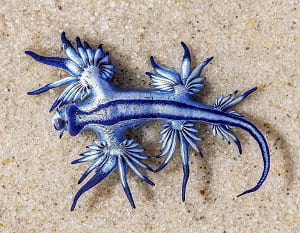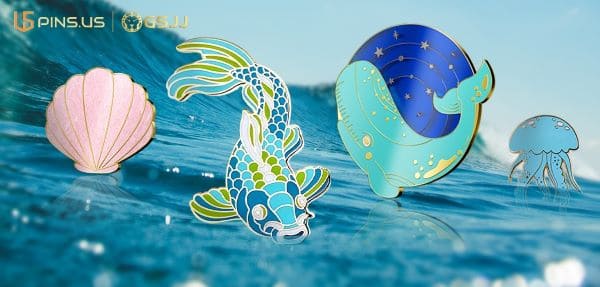Home › Sea Life › Marine › Invertebrates › Mollusks › Nudibranchs › Blue Glaucus
Facts about the Glaucus Atlanticus Sea Slug
[Glaucus atlanticus] [Phylum: Mollusca] [Class: Gastropoda] [Order: Nudibranchia] [Family: Glaucidae]
A combination of dazzling blue tones, and the pelagic lifestyles of these eolid nudibranchs, help to distinguish them from other common species of soft-bodied, gastropod mollusks.
This section contains interesting facts and information about the blue glaucus and why it's best not to touch them - even if you think they are dead!
Blue Dragon Global Distribution and Habitat
This small pelagic sea slug thrives best in open ocean ecosystems (e.g. the Atlantic, Pacific, and Indian oceans).
In fact, they live in ocean areas that are away from any shorelines and they also tend to stay away from the sea floor.
Despite this, the natural habitat of the blue glaucus slug species seems to be experiencing an expansion.
There have been reports of sightings in some unusual regions, such as in the waters around Europe, the east and south coasts of South Africa, close to Mozambique, and off the east coast of Australia.
In general, they use strong ocean currents and wind for a means of transport. As a result, the movement of water often carries them to some undesired coastal locations, where they usually get stranded on the beach and die.
Appearance and Unique Characteristics
It's uncommon for blue glaucus sea slugs to reach more than three (3) centimetres in length, even when they fully mature. Yet, these benthic nudibranchs that weigh less than 100 grams possess a potent arsenal of deadly venom and defencive weaponry.
These small marine invertebrates use their bright blue hue and greyish underbelly as camouflage. The combination of this unique colouring also helps to conceal them from airborne predators in the backdrop of ocean waves.
Here's the best part:
A phenomenon called 'countershading' helps pelagic creatures avoid attacks from above and below. But, Glaucus atlanticus species can exist almost anywhere in the water column - or float at the surface. It does so by storing an air bubble in a gas-filled sac inside its stomach to achieve buoyancy.
 Even though the scientific name for the blue glaucus is Glaucus atlanticus, other common names include:
Even though the scientific name for the blue glaucus is Glaucus atlanticus, other common names include:
- Blue angel
- Blue dragon
- Blue ocean slug
- Blue sea dragon
- Blue sea slug
- Dragon slug
- Sea swallow
The flat, tapered body of the blue glaucus contains six distinct appendages. Each one branches out into eighty four (84) finger-like structures called 'cerata'. Its radular teeth resemble the serrated edge of a knife.
At first glance, it may look like an angelic creature floating at the surface. But, it is best known for stealing toxins - by eating the venom of their prey.
 Engraving Blue Glaucus on Custom Pins is also a cool new idea!
Engraving Blue Glaucus on Custom Pins is also a cool new idea!
They can be designed as a badge with a compass, thermometer, or small storage space.
This not only shows your love for blue seals but also provides practical help during outdoor activities.
Whether as souvenirs, collectibles or promotional items, these Pins can bring us unique experiences and memories.
What Do Glaucus Atlanticus Eat?
The feeding habits of these foraging predators is best described as 'voracious'. To prove a point, they will use their rasp-like tongue to feast on other pelagic species that are much bigger in size.
Even so, the highly venomous Portuguese man of war accounts for large parts of their staple diet. Besides eating poisonous cnidarians (e.g. by-the-wind sailor hydrozoa), blue glaucus sea slugs will also recycle the stinging cells to defend itself from predators.
In case you were wondering:
Hard disks inside the skin of blue glaucus also contain a protective layer of mucus. This is important because they often store large amounts of nematocysts (stingers) from their prey.
Like most soft-bodied, shell-less sea slugs, the blue glaucus is not venomous itself. But, they pose a greater threat to humans than most of the jellyfishes species that they eat. So, you should not touch Glaucus atlanticus to avoid getting a painful sting.
Blue Dragon Reproduction and Lifespan
In fact, the average life expectancy for Glaucus atlanticus hermaphrodites is only a few months (up to a maximum of one year).
Even though these sea slugs produce eggs and sperm, they still need to float around and find another slug to mate and then produce viable eggs.
As you may expect, they must use a lot of caution during the reproductive activities to avoid getting stung by their chosen partner. When mating, a long, curved S-shape bend in the penis helps to keep them safe. This process can result in the release of up to twenty (20) eggs.
Blue Glaucus Predators and Threats
Like most marine animals, the blue sea dragon is facing some global challenges to its existence. Typical examples include:
- Cannibalism: Yes, this predatory nudibranch will not hesitate to eat other blue glaucus when the opportunity presents itself.
- Climate Change: Global warming and ocean acidification is becoming an additional threat to their survival.
- Danger from Humans: Worldwide use of the Internet has contributed to the 'detrimental' popularity of the blue glaucus species (e.g. excessive capture for the aquarium trade).
- Natural Predators: Some studies suggest that loggerhead sea turtles may be a prevalent predator of Glaucus atlanticus. In fact, one particular study revealed that blue sea dragons accounted for 42% of the food in their stomachs.
Note: Like many species of marine invertebrates with pelagic lifestyles, there is limited documentation about the conservation status of Glaucus atlanticus.
Fun Facts about Blue Glaucus Species
- A 'blue fleet' is the collective noun for a group of blue glaucuses floating together en masse. Even if they get washed ashore and die, the venom remains active and they can still sting any humans that come in contact with it.
- This stinging nudibranch can float on top of the water column by swallowing air and then holding it inside their stomach.
- The blue ocean slug often lays its eggs on the carcasses of their prey or other floating structures in the water.
- Upon full maturity, most blue glaucuses will grow to reach a length of 1.2 inches long (3 cm). In general, their diet will include large venomous prey, including the Portuguese men-of-war and blue button jellyfish.
Related Information and Help Guides
- Nudibranch Sea Slugs Facts and Species Information
- Chromodoris Lochi Facts and Information with Pictures
- Hypselodoris Bullockii Facts and Information with Photos
- Nudibranch Anatomy and Body Parts with Labeled Diagram
- Why is the Cone Shaped Snail Such a Dangerous Mollusk?
Note: The short video [1:54 seconds] has some additional facts about the blue glaucus species (Glaucus atlanticus).